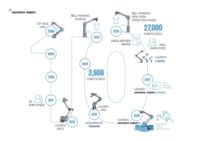Robot, Robots, Everywhere!
Robots are the go-to tool for manufacturers wanting to increase throughput along with quality and efficiency.

Now as you walk the trade show aisles, you see robotics more and more and the capabilities advance every single year.
The explosive growth of robots shouldn’t come as a surprise to anyone, especially in manufacturing. We are not quite to the level of a ‘90s action movie, but robots are certainly popping up in a lot more places these days. What may come as a surprise is the many ways companies are now using these robots, especially when it comes to metrology.
While industrial robots were once vanquished to use only in the most strenuous portions of the manufacturing process, today’s robots have shed the persona of being nothing more than automated mules hell bent on putting pieces together as fast as possible. In fact, reality is quite the opposite. Robots now play a large, and growing, role for quality control and are the go-to tool for manufacturers wanting to increase throughput along with quality and efficiency.
There also have been great improvements and advancements in safety with the introduction of the collaborative robots, or co-bots, allowing the robot to infiltrate so many other areas of the factory, with the quality lab and inspection processes being no exception.
As the manager of the sales solutions team here, I have seen a very rapid increase in requests to automate applications and acquire direct feedback to the process, closing the loop on quality and process control. There is a big push to use flexible measurement systems that allow the option to quickly change parameters when the process or demands of the end user change. Therefore, we find ourselves more and more incorporating what has traditionally been confined to the lab right out on the shop floor, closing the distance between manufacturing and quality control, which in turn leads to more efficient processes making the manufacturer more profitable.
We also no longer talk about robots replacing people and the jobs that they do. The dominant role now is making people more efficient in the tasks that they perform. One example is how robots can move parts from the manufacturing process and onto one of many different metrology solutions such as a CMM or vision measuring system with precision. Many of the latest measuring systems have built-in robots of their own, as they are automated to discover, measure, process and report with minimal human interaction.
This technology is a leading factor in manufacturing and production with a continued shortage of available workers willing to take on manufacturing jobs. With this challenge, robots are now some of the only options available to aid manufacturers in achieving their productivity goals without sacrificing quality or precision, even when shorthanded. With that, the level of support necessary to maintain all of these high-tech tools has created the need for a much more technically savvy worker. With a new generation of worker emerging, this will bode well for the generation brought up in a realm of drones and video games. We see this push in many of our education institutions. It is no longer considered a step down to consider STEM training and the career paths it represents. As many of these careers offer a shorter path to independence and security for the future career seeker.
While robots are still a very strong solution for machine tending, part handling and other repetitive tasks, they also are now handling some of the tasks that many thought to be impossible due to the nuances that some processes require. With the addition of force sensing and vision guided capabilities, these robotic systems can now make adjustments to their processes on the fly. As more enhanced AI technology emerges, we will see this capability really start to make very large strides in reducing the error that sometime plagued automating variable processes. We also have robots performing many of the repetitive transportation tasks within the factory. Delivering raw materials, assembly components and transferring parts from one process line to another, these have become known as RGVs (Robotic Guided Vehicles). This is some of the technology we are seeing adapted to our everyday lives in the attempt to bring autonomous driving to the mainstream consumer.
With the development of many new measurement sensors, whether it is white light, structured light, laser interferometry and many others, this has led companies to look at robots for an off-the-shelf approach to guiding these sensors on their path to good reliable and repeatable measurement analysis. Historically in many cases, these sensors started by having a human guide them along the path of measure. As with many human operated processes, the introduced variation caused the sensor to not perform to their optimum levels, as no two people will follow the exact same path or even the same path twice. In the pursuit of better accuracy and repeatability, this has led to the use of robotic arms to supply the repeatable path guidance that many of the sensors require to achieve the maximum level of success. Now as you walk the trade show aisles, you see this more and more and the capabilities advance every single year.
There are also potential pitfalls out there that await manufacturers that try to over automate or apply robots where they just are not suited. We have seen many attempts to use robotic arms for positioning of surface finish testers. While there have been many successes using skidded technology in this application, the rigidity of most systems out there are not stiff enough to handle skid less measures without inducing some noise. Even with motors turned off and the brakes engaged, there are always some natural frequencies that can be accentuated by what we call the “tuning fork effect.” So always be careful of how a change in the process of data acquisition can affect the overall performance of the measurement equipment you are trying to include. Always do a thorough analysis of the plan and certainly do proof of concept testing before making a serious investment in new strategies. Q
Looking for a reprint of this article?
From high-res PDFs to custom plaques, order your copy today!





